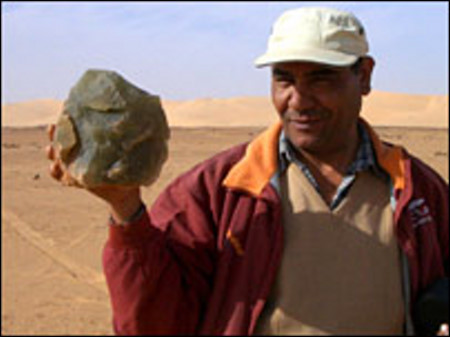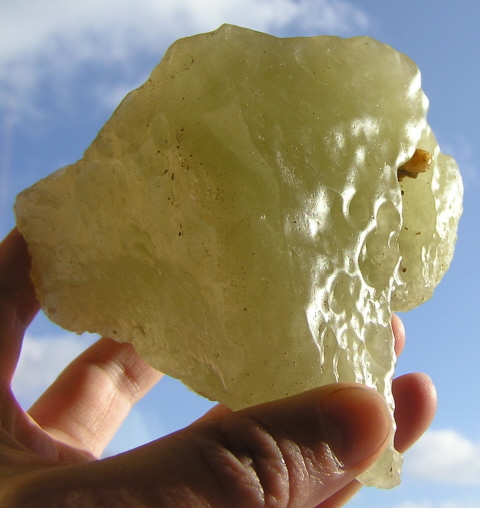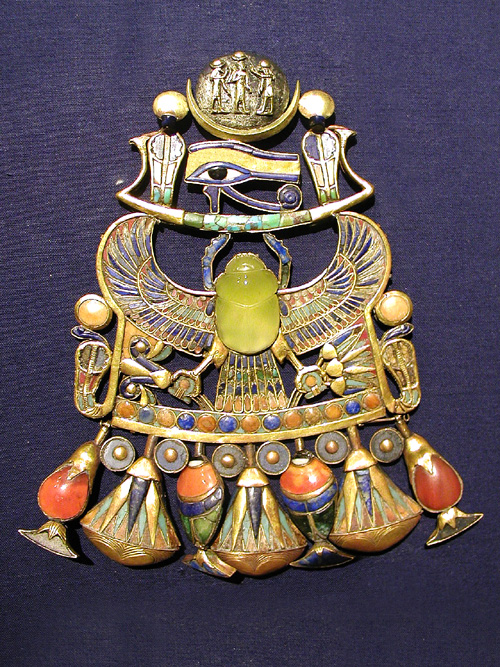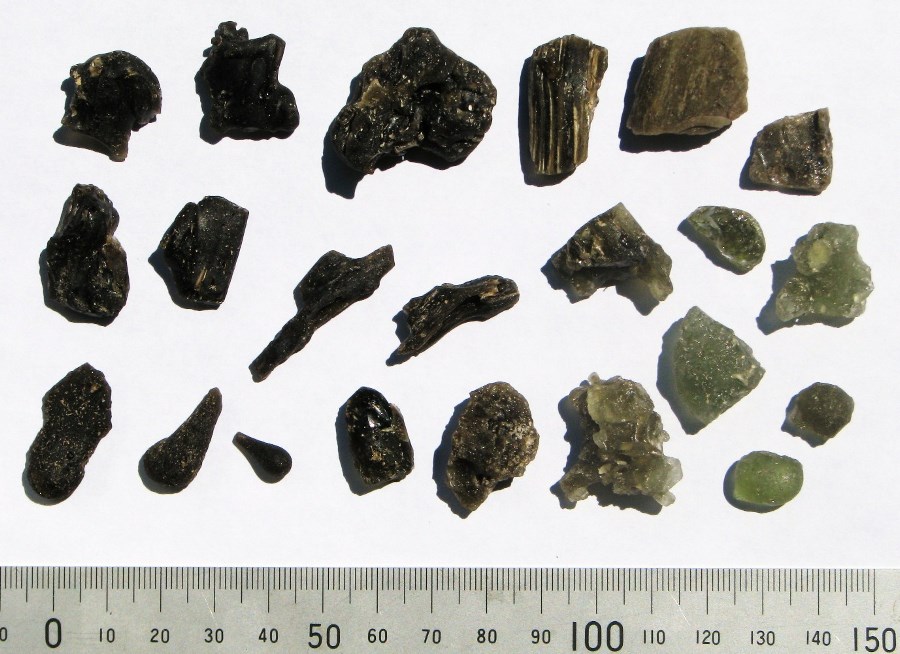|
The Enigmas on Earth |
||
|
Desert glass has been found in all the deserts around the world. The origin of this glass is a mystery. While some has been shown to be possibly associated with meteorite strikes, it is rare to find the glass associates with meteorites. There are large meteorite strikes documented in the deserts and collected that have no trace of meteorites... and large areas of glass found covering kilometers with no sign of a meteorite strike, as in the case of Libyan Desert Glass. On top of that there is such glass found in areas where there have been nuclear explosions. So were the deserts of the world created by ancient wars? Or did something else produce the heat needed to explain the amount of glass found in the deserts? |
||
along the border. This specimen weights 22 grams and is about 55 mm wide. Credit: H. Raab Libyan desert glass (LDG), or great sand sea glass is a substance found in areas in the Libyan Desert. Fragments of desert glass can be found over large areas, up to tens of kilometers. Geologic origin The origin of the glass is a controversial issue for the scientific community, with many evolving theories. Meteoritic origins for the glass were long suspected, and recent research linked the glass to impact features, such as zircon-breakdown, vaporized quartz and meteoritic metals, and to an impact crater.Some geologists associate the glass not with impact melt ejecta, but with radiative melting from meteoric large aerial bursts. If that were the case, the glass would be analogous to trinitite, which is created from sand exposed to the thermal radiation of a nuclear explosion. The Libyan desert glass has been dated as having formed about 26 million years ago. It was knapped and used as a tool during the Pleistocene Era. However, since no glass can survive longer than 100,000 years or so without recrystalizing, this date is problematic. References:
|
||
| Desert Glass - An Enigma
Written by John W. Olsen and James R. Underwood In December 1932, an Egyptian Desert Survey expedition led by P. A. Clayton was sent southwest from Cairo to study the previously unexplored regions of the Egyptian Sand Sea, north of a broad plateau, the Gilf Kebir. On December 29 of that year, members of the expedition discovered, scattered about on the desert, transparent to translucent pieces of a pale yellow-green vitreous substance that has since become known as Libyan Desert glass. Located in the Great Erg, or Sand Sea, on the Egyptian-Libyan frontier, the area where the glass is found measures roughly 80 miles north and south by 30 miles east and west in the corridors between a series of dunes (saifs) that rise abruptly above sharply contrasting weathered debris that overlies bedrock of the Nubian Sandstone deposited during the Early Cretaceous Epoch some 100 million years ago. Although the glass was used for tools by Pleistocene man, and may have been discovered as early as 1846 by explorers, the inaccessibility of the region and the harshness of the terrain precluded any further investigation until Clayton went back in 1934 with L. J. Spencer, then Keeper of Minerals in the British Museum. And it was not until 1971, when a joint University of Texas-University of Libya team explored the western extremity of the area, that modern science had a look. Indeed, the terrain is so remote and inhospitable, that when the American-Libyan team neared the site of the glass deposits, they discovered an Egyptian plane, intact, with the remains of nine passengers scattered about, lying where they died of thirst several days after they landed, lost and out of fuel, more than three years earlier.
The glass has generated intense interest among scientists because its origin remains an enigma. Was it produced by the encounter of an extraterrestrial body with earth? Science isn't sure and, in fact, has come up with at least 10 theories to explain its origin. Many researchers consider Libyan Desert glass to be a form of tektite (from the Greek tektos, meaning molten), a natural black, dark green, or dark brown glassy stone, resembling the volcanic glass obsidian, that may possibly be of extraterrestrial or meteoritic origin. Tektites, which occur in four large associations of distinctly different ages throughout the world known as strewn fields, are similar to Libyan Desert glass in that both substances are composed chiefly of silica (silicon dioxide); the silica content of tektites ranges from 68-80 percent whereas that of Libyan Desert glass is approximately 98 percent. Both tektites and Libyan Desert glass are characterized by etched, pitted surfaces, which in the case of some of the silica glass may have been obscured by the scouring action of the fierce Saharan winds. Tektites, first scientifically reported in 1788, have been the subject of investigation since that time. In 1844, for example, Charles Darwin, the great naturalist, described a specimen he was given in Australia while on the famous globe-circling voyage of H.M.S. Beagle from 1831-1836. Undoubtedly of natural origin, tektites have been interpreted by various investigators as: (1) ejecta from terrestrial volcanoes, (2) meteorites, (3) ejecta from lunar volcanoes, (4) glassy material produced by lightning striking the earth, (5) glassy material produced by lightning discharge into the dusty, hot gases of a volcano's eruptive cloud, (6) the product of desiccating siliceous gels, (7) glassy debris from a disrupted planetary body with a glassy surface layer, (8) material produced by forest fires, (9) glassy material produced by meteorite impact on earth, or (10) similar material resulting from meteorite impact on the moon. It was even argued by some, for a time, that tektites had been produced by human activities such as furnace operations or as a by-product in the manufacture of glass. The shape of tektites is varied; they may resemble buttons, teardrops, dumb-bells, rods, spheres, or disks. Some are blocky and layered. Although commonly about an inch in diameter, they range up to a maximum diameter of almost 12 inches and weigh as much as 28 pounds. Many tektites show the effects of surface etching and pitting - interpreted by most specialists as having developed through chemical action during burial on the earth's surface. Some tektites, especially those from Australia, show a distinctive surface sculpture almost certainly produced by aerodynamic ablation as the glassy object hurtled through the earth's atmosphere. It was this characteristic of some tektites that drew special attention to them as the pace of the U.S. space program to reach the moon quickened. Tektites provided a model for the design of heat shields with which to protect spacecraft returning to earth through the atmosphere. Suddenly these curious objects of heretofore relatively minor interest were center stage, because they had already journeyed through the earth's atmosphere, and many were readily available for study. The chemical composition of tektites is similar to that of crustal rocks of the earth, and the discovery in some tektites of rare minerals produced only by extremely high pressure has led many to believe that tektites are a form of glass, impactite, produced by meteorite impact. This view was further enhanced by the discovery in some tektites of small spheres (spherules) of nickel-iron, the material of which many meteorites are composed. Specialists were divided, however, on whether tektites were produced by impact on earth and were consequently splashed into their strewn fields, or whether the impact events occurred on the moon with some of the ejecta reaching lunar escape velocity and reaching earth as a form of meteorite. The hypothesis of lunar origin of tektites was dealt a severe blow by the failure of samples returned from the moon by the Apollo missions to contain any tektite-like material or plausible tektite parent material. Some large terrestrial impact craters have been identified as being of the correct age and location to be the parent craters for some of the tektite-strewn fields, but for some strewn fields no parent craters have thus far been identified. Based on aerodynamic arguments however, some investigators feel that tektites cannot have a terrestrial origin and be distributed as they are in strewn fields. They further maintain that tektites can only have come from certain lunar volcanoes that are believed to have erupted material at lunar escape velocity in the directions necessary to result in impact with the earth. And so the debate continues.
Is Libyan Desert glass a tektite? Although it usually is discussed in the same context as tektites and is considered by some investigators to be a variety of tektite, there exist some very distinct differences. Libyan Desert glass has a uniformly higher silica content than tektites, and it shows no evidence of aerodynamic sculpturing. Many of the fragments are tabular and layered, which is characteristic of only one kind of tektite, the so-called Muong-Nong tektites of southeast Asia. Libyan Desert glass never occurs in such distinctive shapes as dumbbells, rods, spheres, disks, and teardrops as do tektites, and the color of the glass is rarely as dark as the color of typical tektites. In fact, some of the glass is quite colorless. It ranges in size from tiny flakes 0.01mm in diameter up to pieces the size of a person's head and weighing over 16 pounds. Both tektites and Libyan Desert glass are harder than the steel in a knife blade, but no harder than the mineral quartz. Fragments of Libyan Desert glass are somewhat lighter weight than tektites of equal size. Both tektites and Libyan Desert glass may contain bubbles; those in the glass tend either to be elliptical, indicating deformation of the bubble during flow, or elongated and pointed, suggesting deformation of original pore space in material that barely melted. Analyses of both major and trace elements of the glass and of the Nubian Sandstone upon which it rests, together with the stratification visible in numerous pieces, have revealed that the Nubian Sandstone is a suitable parent material for Libyan Desert glass and suggest that the glass could be of impact origin. What is not yet understood is the mechanism that produced, momentarily, heat intense enough to melt surface rock or weathered debris. For the quartz-rich Nubian Sandstone, the melting temperature would be about 2,800°F. Although nickel-iron spherules have not been identified in the glass, it is still possible that it was formed by the impact of a stony meteorite (or aerolite). There are, for instance, two small craters in the desert glass area, and although there is no evidence relating the craters to the glass, it would be an unusual coincidence to find such rare material as Libyan Desert glass so close to such relatively rare structures as astroblemes (deeply eroded impact features) without some relationship. Virgil Barnes has suggested that perhaps the glass was produced by the heat wave of a passing comet or by the intense heat generated by an exploding comet - neither of which would necessarily disrupt the surface rocks. Afterwards, the molten silica glass may have flowed into low areas, puddled and cooled - thus forming Libyan Desert glass. Later, it may have been broken up by weathering and then moved, either by running water, in an earlier, wetter climatic period, or by humans in prehistoric times. On the other hand, most Libyan Desert glass is much more dense and homogeneous than the well described porous and impure "impact" glass (impactite) found in such craters as Henbury in central Australia, Wabar in the Rub'al-Khali of Saudi Arabia, or 4 the nuclear test craters in Nevada. The absence of an extremely large impact crater in the vicinity of the Libya Desert glass, moreover, is not highly relevant. The glass has been reliably dated (by fission-track methods), as 28.5 million years old. That’s so long ago that any impact crater may have been covered by shifting sands or erased by erosion. Opponents of the cometary or meteoritic origin of Libyan Desert glass say it is highly improbable that such large, homogeneous pieces of glass could be formed and freed of volatiles within the earth's atmosphere by any process of simple fusion of sand, while supporters contend that the chemical composition of Libyan Desert glass so closely resembles the Nubian Sandstone - upon which it rests -that the probability of finding two so similar yet unrelated materials together is extremely remote. Obviously, the origin of Libyan Desert glass is unresolved and remains a topic of intense discussion among tektite specialists. But most scientists do agree that ancient man used the glass at a time when the Sahara's climate was quite different. For nearly 10,000 years, the Sahara, of which the Great Erg or Sand Sea is a part, has been a hot, forbidding land, unattractive in most regions to human habitation. But 50,000 years ago, what is today the Sand Sea may have closely resembled the Mediterranean environment of modern Greece and was thus more habitable. As a result, in the latter phase of the Palaeolithic (or Old Stone Age) there appeared the Aterian culture, named after an archaeological site in eastern Algeria. Appearing about 30,000 years ago and persisting until perhaps 18,000 years ago, the Aterian people were apparently the first to recognize Libyan Desert glass and make use of its special properties. Like many types of glass, that from the Libyan Desert flakes conchoidally. That is, by striking the material a glancing blow with another rock, or baton of wood or bone, flakes may be removed in a predictable fashion so as to produce a variety of efficient cutting edges. The Aterian people used this property of Libyan Desert glass to their advantage and produced an array of skillfully-flaked implements (See page 4, top). After their expeditions in the 1930's, Clayton and Spencer said that at least 10 percent of the Libyan Desert glass flakes recovered exhibited some sign of human workmanship and Virgil Barnes and James Underwood, who visited the Libyan Desert glass strewn field in 1971, reported that the largest specimen collected during their expedition - a tabular cobble weighing nearly two pounds - shows percussion marks that suggest the piece may have been used as a pounding tool. Flakes of Libyan Desert glass have also been found in localized concentrations suggesting the manufacture of implements on the spot. Other fragments of the glass have been located some 140 miles from the known field - and in a few instances on the top of the saif dunes, suggesting transport by man. On the basis of the above evidence it is logical to conclude that by Aterian times, Libyan Desert glass was used for the manufacture of lithic tools. But there is still an enigma: although Libyan Desert glass has been dated as 28.5 million years old, there is no evidence that man used it before Aterian times even though much older Nubian Sandstone handaxes have been found. One plausible solution to this problem, offered by Virgil Barnes, is that the area that is now the Sand Sea may have been covered by thick deposits of sand prior to the climatic perturbation of the late Pleistocene age that could have whipped the sand up into saif dunes, thus exposing the Libyan Desert glass below. On the other hand, the highly polished and faceted surface of many of the exposed Libyan Desert glass fragments indicates that some of them have been exposed to the abrasive actions of wind and sand for a good deal longer than 30,000 years. As Kenneth Oakley has pointed out in Nature,"... it is important to bear in mind that the glass was already corroded by sand-blast before it was worked into the [Aterian] bifaced points." Naturally, it is possible that the Libyan Desert glass lay on the surface for some 26 million years or so before the arrival of humans on the scene and was then covered for a short period up to about 30,000 years ago when the Aterian people began to utilize the material. Nevertheless, it remains an important task for archeologists working in this region to investigate the possibility of pre-Aterian occurrences of Libyan Desert glass artifacts. Since the time of the Aterian's utilization of the substance, humans have found no practical use for Libyan Desert glass. From a scientific viewpoint, however, its existence continues to provoke intense curiosity regarding the formation of such unique material. Fundamental questions relating to the nature of Libyan Desert glass have yet to be adequately resolved. Can it be considered a true tektite? How did Libyan Desert glass come to be formed in such large, relatively homogeneous masses? Why the striking similarity between the silica glass and the Nubian Sandstone upon which it rests? Coincidence? Perhaps; perhaps not. One hopes that continued diligent research will provide us with answers to these questions and perhaps shed light upon the origin of other tektites as well. John W. Olsen is a Ph.D. candidate in Old World prehistory at the University of California and James R. Underwood heads the Department of Geology at Kansas State University. This article appeared on pages 2-5 of the September/October 1979 print edition of Saudi Aramco World. SOURCE: Saudi
Aramco World
Copyright and Permissions Texts of articles copyrighted by Saudi Aramco World or Aramco World may be reprinted, either in print or electronically, without specific prior permission from the publisher, provided the following three conditions are met:
|
||
|
..
Tut's gem hints at space impact - BBC News, July 19, 2006 In 1996 in the Egyptian Museum in Cairo, Italian mineralogist Vincenzo de Michele spotted an unusual yellow-green gem in the middle of one of Tutankhamun's necklaces. The jewel was tested and found to be glass, but intriguingly it is older than the earliest Egyptian civilisation. Working with Egyptian geologist Aly Barakat, they traced its origins to unexplained chunks of glass found scattered in the sand in a remote region of the Sahara Desert. But the glass is itself a scientific enigma. How did it get to be there and who or what made it? The BBC Horizon programme has reported an extraordinary new theory linking Tutankhamun's gem with a meteor. Sky of fire An Austrian astrochemist Christian Koeberl had established that the glass had been formed at a temperature so hot that there could be only one known cause: a meteorite impacting with Earth. And yet there were no signs of a suitable impact crater, even in satellite images. American geophysicist John Wasson is another scientist interested in the origins of the glass. He suggested a solution that came directly from the forests of Siberia. "When the thought came to me that it required a hot sky, I thought immediately of the Tunguska event," he told Horizon. In 1908, a massive explosion flattened 80 million trees in Tunguska, Siberia. Although there was no sign of a meteorite impact, scientists now think an extraterrestrial object of some kind must have exploded above Tunguska. Wasson wondered if a similar aerial burst could have produced enough heat to turn the ground to glass in the Egyptian desert. Jupiter clue The first atomic bomb detonation, at the Trinity site in New Mexico in 1945, created a thin layer of glass on the sand. But the area of glass in the Egyptian desert is vastly bigger. Whatever happened in Egypt must have been much more powerful than an atomic bomb. 
Dr Mark Boslough, Great Sand Sea (BBC) Boslough's specialism is modelling large impacts Impact simulation
A natural airburst of that magnitude was unheard of
until, in 1994, scientists watched as comet Shoemaker-Levy collided with
Jupiter. It exploded in the Jovian atmosphere, and the Hubble telescope
recorded the largest incandescent fireball ever witnessed rising over Jupiter's
horizon.
Mark Boslough, who specialises in modelling large impacts on supercomputers, created a simulation of a similar impact on Earth. The simulation revealed that an impactor could indeed generate a blistering atmospheric fireball, creating surface temperatures of 1,800C, and leaving behind a field of glass. "What I want to emphasise is that it is hugely bigger in energy than the atomic tests," said Boslough. "Ten thousand times more powerful." Defence lessons The more fragile the incoming object, the more likely these airborne explosions are to happen. In Southeast Asia, John Wasson has unearthed the remains of an event 800,000 years ago that was even more powerful and damaging than the one in the Egyptian desert; one which produced multiple fireballs and left glass over three hundred thousand square miles, with no sign of a crater. "Within this region, certainly all of the humans would have been killed. There would be no hope for anything to survive," he said. 
Dr Aly Barakat with desert glass in hand (TV6/BBC) Barakat holds up one of the many, huge chunks of glass in the desert According to Boslough and Wasson, events similar to Tunguska could happen as frequently as every 100 years, and the effect of even a small airburst would be comparable to many Hiroshima bombs. Attempting to blow up an incoming asteroid, Hollywood style, could well make things worse by increasing the number of devastating airbursts. "There are hundreds of times more of these smaller asteroids than there are the big ones the astronomers track," said Mark Boslough. "There will be another impact on the earth. It's just a matter of when." Horizon: Tutunkhamun's Fireball, made by production company TV6, was broadcast on BBC Two on Thursday, 20 July Tut's gem hints at space impact - BBC News, July 19, 2006 |
||
Darwin glass is a natural glass found south of Queenstown in West Coast, Tasmania. It takes its name from Mount Darwin in the West Coast Range, where it was first reported, and later gave its name to Darwin Crater, a probable impact crater, and the inferred source of the glass. Occurrence Fragments of Darwin glass are found scattered over a 410 km² area. Such an area is called a strewn field. On slopes and flat ground between 250 and 500 m elevation, the glass occurs with quartzite fragments buried under peat and soil. The peat is normally around 20 cm thick, and the quartzite fragment horizon is typically 30 cm thick. On mountain peaks higher than 500 m, the bedrock is directly exposed to the air, and Darwin glass occurs occasionally on the surface. In valleys below 220 m the Darwin glass is buried below peat and sediments. The glass occurs north, west and south from the crater. Its distribution extends to Kelly Basin and the lower northeast shore of Macquarie Harbour. Northwards it extends almost to the Lyell Highway and Crotty Dam. Darwin glass is rare in the crater itself. In controlled excavations of gravel deposits the abundance of Darwin glass was found to vary from 0.3 to 47 kg/m³. The highest abundance was found about 2 km from the crater, with the average abundance estimated at 3.4 kg/m³ of gravel over a 50 km² study area near the crater. From this it can be estimated that about 25000 tons of Darwin glass, or about 10000 m³, occurs in this 50 km² area. The amount of glass is large compared with the size of the crater. Preservation is helped by acid ground water which does not dissolve the glass, but this alone cannot explain the glass abundance. There is so much glass present that the glass must have been more copiously produced than in other meteorite impacts of similar size. Nature The glass is light to dark green, white or black. The glass takes the form of twisted masses, fragments or chunks up to 10 cm. Internally it has a flowing texture defined by lines of elliptical bubbles.[2] There are two kinds of Darwin glass when composition is measured. Type 1 is normally white or green whereas type 2 is normally black to dark green. The dark glass contains less silica and more magnesium and iron than the light green glass. The dark glass is also enriched in chromium, nickel and cobalt. A possible explanation for the chemical differences is that, in addition to being mainly composed of melted local metamorphic rocks, the type 2 glass also contains a component of extraterrestrial material from the meteorite.[3] Darwin glass has been dated at about 816,000 years old using argon dating methods.[4] Since glasses have been shown to recrystallize rapidly (on a geologic timescale), with a maximum age of ~100,000 years, such a date is problematic. Crater The glass is an impactite resulting from the melting of local rocks due to the impact of a large meteorite. The assumed source is a 1.2-kilometer-wide topographic depression known as Darwin Crater. The crater is filled with 230 m of sediments and breccia. A crater of that size would be created by a meteorite 20 to 50 m in diameter and its impact with Earth would release 20 megatons of energy. SOURCE: Darwin glass Related Links:
|
||
| FAIR USE NOTICE: This page contains copyrighted material the use of which has not been specifically authorized by the copyright owner. Pegasus Research Consortium distributes this material without profit to those who have expressed a prior interest in receiving the included information for research and educational purposes. We believe this constitutes a fair use of any such copyrighted material as provided for in 17 U.S.C § 107. If you wish to use copyrighted material from this site for purposes of your own that go beyond fair use, you must obtain permission from the copyright owner. | ||
|
|






